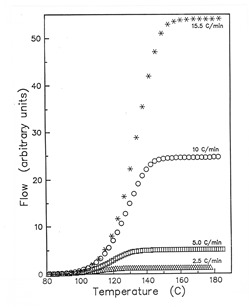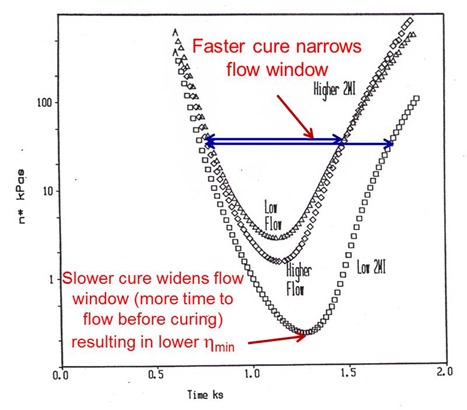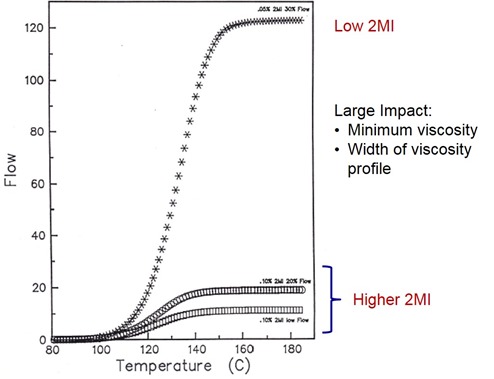 In the last post we discussed how changing the resin content and the prepreg degree of B-stage advancement impacted the flow during lamination and the viscosity profile during non-isothermal curing. Another technique used to tailor the flow during processing is to vary the curing kinetics. Typical thermosets have a reactive resin and a hardener (crosslinking agent). Some systems use a cure accelerator or catalyst. In this example we will show how changing an imidazole hardener (2-methyl imidazole or 2MI) impacts the viscosity integral and the flow number. The amount of 2MI in the formulation controls the rate of crosslinking, thus as the 2MI is increased, the curing reaction increases.
In the last post we discussed how changing the resin content and the prepreg degree of B-stage advancement impacted the flow during lamination and the viscosity profile during non-isothermal curing. Another technique used to tailor the flow during processing is to vary the curing kinetics. Typical thermosets have a reactive resin and a hardener (crosslinking agent). Some systems use a cure accelerator or catalyst. In this example we will show how changing an imidazole hardener (2-methyl imidazole or 2MI) impacts the viscosity integral and the flow number. The amount of 2MI in the formulation controls the rate of crosslinking, thus as the 2MI is increased, the curing reaction increases.
Let’s take a look at how this works. In the following figure a lot is going on.
We have three different prepreg samples.
- The upper curve has a higher level of 2MI (hardener) and a low flow number
- The middle curve has the same level of 2MI as the upper curve, but has slightly higher flow. So with the top two curves, the only difference is the amount of flow.
- The lower curve has a low level of the 2MI hardener
Since the upper two curves has the same amount of 2MI, one observes that the width of the flow window is the same. This is to be expected since the cure kinetics control the width of the viscosity curve. Recall that for a B-staged prepreg, there is an initial rapid viscosity drop once the prepreg goes through the Tg. At higher temperatures, the hardener system initiates rapid curing with subsequent increase in the viscosity and crosslink density. Notice the middle curve with the higher flow exhibits a lower minimum viscosity which is what we would expect. In the treater tower the minimum viscosity can be controlled by the heating profile in zones 4 and 5. More heat that is applied will cause more chemical advancement thus a higher minimum viscosity.
The lower curve has a dramatically wider flow window. This was accomplished by using a much lower amount of the 2MI hardener, thus significantly slowing the crosslinking reaction. As seen in the figure, the slower cure widens the flow window since there is more time to flow before the onset of rapid chain extension and the result is a much lower minimum viscosity.
In the following figure, the flow number is plotted as a function of temperature for the prepregs above.
In this case we dramatically changed the viscosity window (the lower two curves are more in the range of typical prepregs with flow numbers around 20%) to enhance the impact of the flow window. One observes that the flow number is similar for the two prepregs with the same 2MI levels and identical width of the viscosity curves. The significantly lower minimum viscosity and wider flow window in the lower 2MI prepreg resulted in a huge flow number. Actually this much flow would be a disaster in an actual lamination process! In all cases the same flow and curing profiles are observed. Remember Dr. Prime and I have discussed gelation and how important this is in processing. In all of the flow number plots one observes the resin flows and then obtains a plateau value. The break in the flow number curve is a result of gelation. As discussed before, gelation is an iso-conversional point that is controlled by the stoichiometry of the resin and hardener. In the above case, the flow number increases until the crosslinking reactions cause gelation. We now have another nice was to look at gelation during thermoset processing.
In the last eight posts we showed how changing the rheology during curing (or processing) is a very useful tool for process engineers. We also demonstrated that measuring the resin flow percent (flow number) continuously provides key insights into how the resin will flow and the process window (i.e. time to gelation where flow stops). B-staged prepreg resin content, degree of advancement (percent conversion) and chemistry (hardener/catalyst level) all play a key role in the rheological properties during composite lamination.
Dr. Prime will be next up with a series on curing using some interesting materials you might have used, Five Minute Epoxy.



Leave a Reply